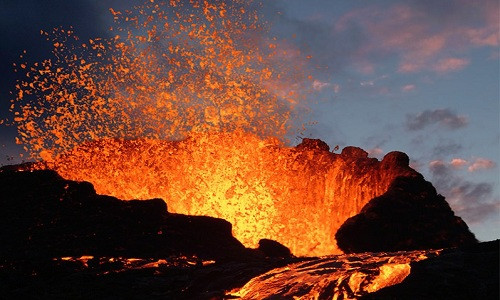The plan bombed American volcanic eruption in 1935
The US Air Force repeatedly bombed volcanic eruptions in Hawaii to block lava flows, causing controversy among scientists.
When erupting on November 21, 1935 and lava flows towards Hilo city in Hawaii at a speed of 1.6 km / h, the army is mobilized to carry out a bold plan: Use a bomb to block volcanoes , according to National Interest.
Thomas Jagger, the founder of the Hawaii Volcanic Observatory, believes a big explosion could collapse lava columns and block its flow. Jagger's original plan was to use tons of tons of TNT explosives on the volcano but not enough time.

An eruption of Mauna Loa volcano in Hawaii.(Photo: Britannica).
Therefore, 10 US Army Air Corps airstrikes (the predecessor of the US Air Force) on December 27, 1935 were deployed to Hawaii. Each aircraft carried two bombs weighing 272kg, containing 136kg of explosives to pour into the Mauna Loa crater.
This bombing was not appreciated for accuracy, some bombs fell hundreds of meters from the target. However, six days after the bombing, the lava flow stopped and Jagger announced that the mission was successful.
But another geologist, Harold Stearns, who sits on a bomber participating in a bombing operation, doubts the effectiveness of this unprecedented plan.
"The lava tube wall is about 8 - 15 meters high and flows very deep, so I think the bomb can't break the walls. The lava has low viscosity. The plan to block lava flow seems effective but the target is too small. " , Stearns commented.
Jagger still insisted that the bombs worked."There is no doubt that the original way to destroy the lava tube slowed the flow of water. The average speed of lava flow in the 5 days after the bombing was about 305 meters per day. For 7 days before the throwing. The bomb, the lava speed is 1.6 km / day, " Jagger said.
This is not the only time seismic weapons are used. During World War II, the British Air Force found bombs that often bounced off a 7.6 meter thick concrete roof of a German submarine vault. Therefore, the British inventor Barnes Wallis created the "earthquake bomb".

American air force aircraft bombs Mauna Loa volcano.(Photo: Buzzfeed).
The 10-ton Grand Slam bomb dropped from Landcaster heavy bombers at a height of 5,486m will descend on the target at supersonic speed and drill deep before exploding. Instead of dispersing the explosive force in the air, the shockwave of this type of bomb is guided through concrete or underground, causing the underground target to be completely destroyed.
Mauna Loa also bombed volcanic bombs in 1975 and 1976 in experiments using 907kg bombs to deflect lava flows. While scientists still debate whether or not volcanic bombing is effective, some experts say this only works in the right conditions.
Some experts believe that the 13.6-ton heavy-duty Bomber- like (MOP) weapons can drill deep into the volcano and break into lava pipes. However, the United States has never tested dropping MOP bombs on craters.
- The drill is in danger of causing an intense volcanic eruption in Italy
- Decode the mysterious volcanic eruption in the 13th century
- Volcanic eruption in the Philippines, 5 people died
- Video: Japan's largest volcano
- Volcanic eruption in Indonesia, 6,000 people evacuated
- This is the cause of the largest volcanic eruption in history
- Video: Volcanic eruption creates 9,000 m high smoke column in Japan
- The most brilliant volcanic eruption in the solar system
- Hawaiian volcano erupted with precious stones, Hawaiian people were eager to pick up
- Volcanic eruption in Indonesia, 7 people died
- Volcanic eruptions create new islands
- The scene of the terrible volcanic eruption in Guatemala
 Is the magnetic North Pole shift dangerous to humanity?
Is the magnetic North Pole shift dangerous to humanity? Washington legalizes the recycling of human bodies into fertilizer
Washington legalizes the recycling of human bodies into fertilizer Lightning stone - the mysterious guest
Lightning stone - the mysterious guest Stunned by the mysterious sunset, strange appearance
Stunned by the mysterious sunset, strange appearance